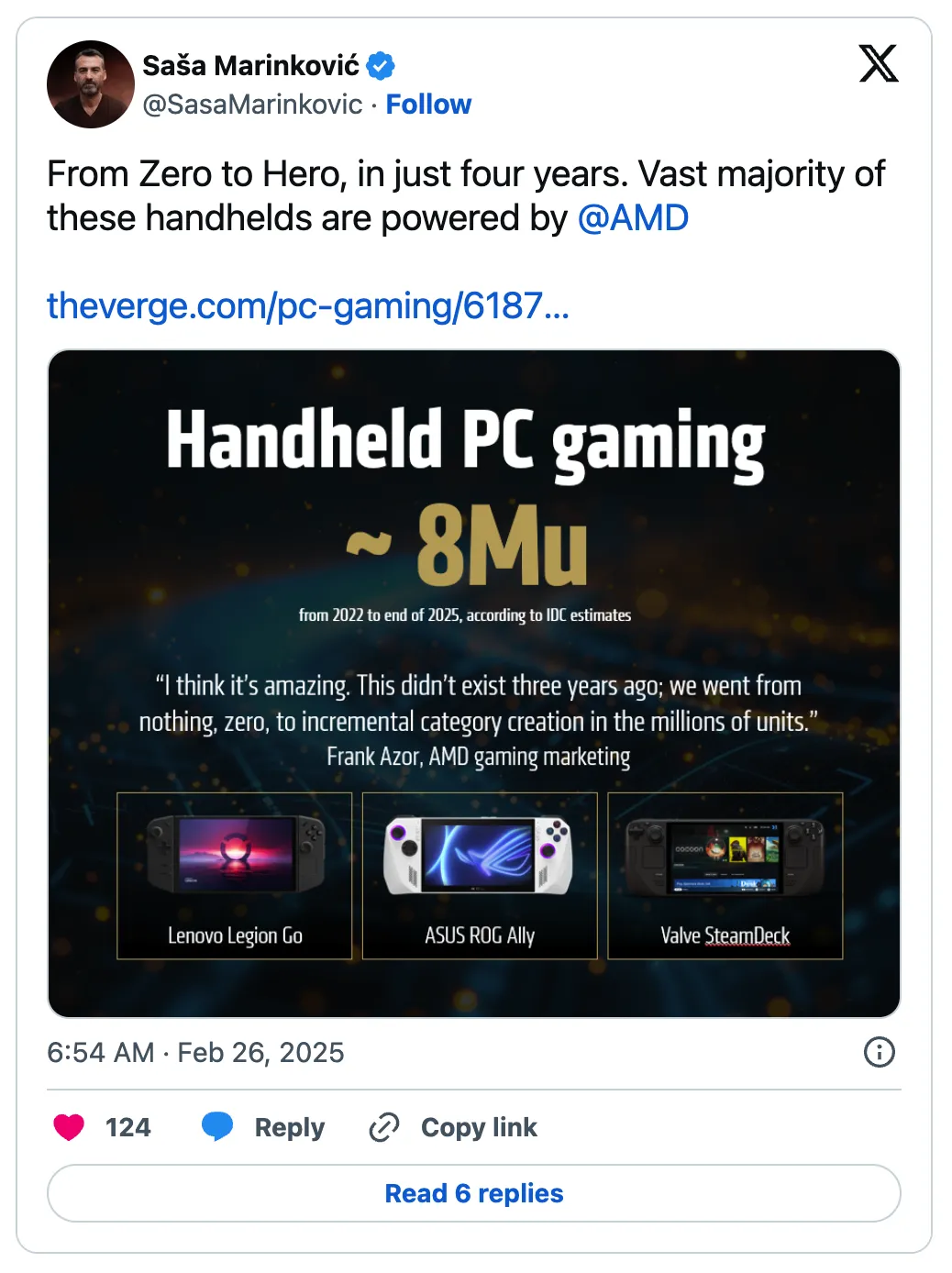In recent years, handheld gaming devices powered by AMD Ryzen chips have surged in popularity, becoming a dominant force in the portable gaming market. According to market research data, since Valve launched the Steam Deck in 2022, shipments of handhelds running Windows and SteamOS have neared 6 million units over the past three years (2022–2024). By the end of 2025, this figure is projected to climb to nearly 8 million units, with AMD processors holding a commanding lead, showcasing their strong competitiveness in this space.
While handheld gaming devices have existed for decades, it wasn’t until the Steam Deck’s debut that portable devices capable of running PC games truly took off. This marked a turning point for the industry. Within just three years, major brands like ASUS, Lenovo, and MSI jumped into the fray with products like the ROG Ally, Legion Go, and MSI Claw, creating a vibrant and diverse market. Although Intel has recently tried to carve out a share with its Lunar Lake chips, AMD’s first-mover advantage and technological expertise have solidified its position at the heart of the market.
From a technical perspective, the widespread adoption of AMD chips in handhelds is no coincidence. When the Steam Deck launched with a custom Zen 2 architecture processor, AMD demonstrated its ability to balance performance and power efficiency. Since then, manufacturers have shifted to more advanced Zen 4 and even Zen 5 architecture chips. For instance, the ASUS ROG Ally and Lenovo Legion Go both feature the Ryzen Z1 Extreme processor, while AMD’s newly released Ryzen Z2 series—including the Z2 Extreme, Z2, and Z2 Go models—has raised the performance bar further. The Z2 Extreme boasts 8 cores, 16 threads, a peak frequency of 5.0GHz, and 16 RDNA 3.5 GPU cores, with a power range of 15–35W, tailored for high-end handhelds. Meanwhile, the Z2 Go targets the entry-level market with 4 cores, 8 threads, and 12 RDNA 2 GPU cores. This diverse product lineup has not only strengthened AMD’s market share but also driven a comprehensive upgrade in handheld performance.
Data shows that of the 6 million handhelds sold, the Steam Deck leads the pack, likely surpassing 4 million units—about two-thirds of the total. Though its hardware lags behind competitors like the ROG Ally, the Steam Deck’s optimized SteamOS interface and seamless gaming experience have won it widespread praise. In contrast, Windows 11-based handhelds, despite their superior hardware, still face system compatibility challenges, which explains why the AMD chip and SteamOS combination remains the preferred choice.

AMD’s confidence in the handheld market is well-founded. Frank Azor, AMD’s head of consumer and gaming marketing, remarked, “Three years ago, this category didn’t even exist. Today, we’ve gone from zero to millions of units, which is incredible.” To maintain its edge, AMD introduced the Ryzen Z2 series in early 2025 and plans to widen the gap with high-performance APUs like Strix Halo. Strix Halo is expected to integrate up to 40 RDNA 3.5 compute units, delivering graphics performance comparable to mainstream desktop GPUs. If successfully implemented in handhelds, it could significantly enhance gaming experiences.
Intel isn’t backing down from the fight. Its Lunar Lake chips have debuted in the MSI Claw 8 AI+, leveraging the Intel Arc 140V GPU and XeSS technology for improved efficiency and frame-rate stability. The upcoming Panther Lake series is rumored to further boost iGPU performance, and if it can overcome power consumption hurdles, it might challenge AMD’s dominance. Market forecasts suggest handheld sales will stabilize at around 2 million units in 2025, with year-over-year growth slowing but overall demand remaining robust.
AMD’s success hinges on its close collaboration with OEM partners. New devices like the ASUS ROG Ally X and Lenovo Legion Go S have confirmed adoption of the Z2 series processors. While Valve has denied that the next-gen Steam Deck will use Z2 chips, AMD says discussions about hardware upgrades are ongoing. Additionally, the Lenovo Legion Go S will launch a SteamOS version, making it the first non-Valve handheld to officially support the platform, further expanding its ecosystem.
Technological advancements are also elevating the handheld experience. On the display front, the ROG Ally X features a 7-inch 120Hz screen, while the Legion Go S opts for an 8-inch 144Hz OLED panel with VRR (variable refresh rate) support, delivering smoother visuals. Storage and memory capacities are improving too, with some top-tier models offering up to 2TB SSDs and 32GB of RAM—enough to handle modern AAA titles. Battery life, a key concern, has been optimized to 6–8 hours in newer models, easing range anxiety for portable devices.
Looking ahead, competition in the handheld market will only intensify. AMD holds the upper hand with Ryzen Z2 and the potential of Strix Halo, while Intel banks on Panther Lake to mount a comeback. In 2025, the handheld gaming boom will undoubtedly continue to heat up, and AMD Ryzen chips’ leading position looks unshakable in the short term.
